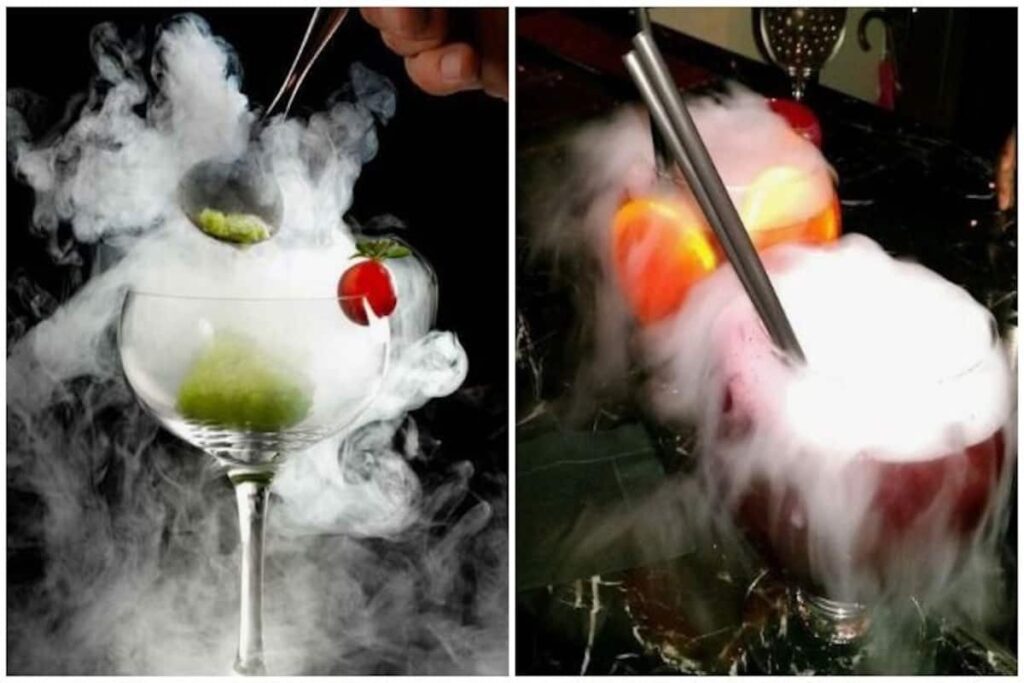Warning on Liquid Nitrogen Safety Amidst Food and Beverage Concerns

Warning on Liquid Nitrogen Safety Amidst Food and Beverage Concerns
Handling liquid nitrogen in food requires utmost caution due to its extreme cold temperature of -195.8°C required for liquefaction. In comparison, household freezers typically reach temperatures around -18°C to -20°C.
The Food Safety and Quality Department of Karnataka has implemented a prohibition across the state on the utilisation of liquid nitrogen in food and drinks.
The state government has restated this declaration to ensure that the public is well informed and abides by the directive. Breaches of this mandate will incur serious consequences, including potential imprisonment for up to seven years and fines reaching Rs 10 lakh.
This decision comes after previous bans on the dyes employed in Gobi Manchurian and Bombay Mithai (cotton candy). Following scrutiny on artificial colours, the health department has heightened its focus on potential health risks associated with the use of liquid nitrogen in food and beverages.
Initially issued on 3rd May, the directive prohibits the utilisation of liquid nitrogen in the creation and presentation of smoked biscuits, desserts, ice creams and other food items in hotels and restaurants.
Liquid nitrogen is frequently employed for swiftly cooling food items and in the crafting of smoked biscuits, beer and ice cream. Nonetheless, its application carries notable health hazards, such as potential harm to the lips, tongue, throat, lungs and stomach, along with the risk of severe tissue burns.
Handling liquid nitrogen in food requires utmost caution due to its extreme cold temperature of -195.8°C required for liquefaction. In comparison, household freezers typically reach temperatures around -18°C to -20°C. Direct contact with the cooled, liquefied gas can cause frostbite on skin and organs. Liquid nitrogen freezes tissues so rapidly that it’s utilised in medical procedures to eliminate warts or cancerous tissues. If consumed, the nitrogen can swiftly transition to its gaseous state as temperatures rise. With an expansion ratio of 1:694 at 20 degrees Celsius, one litre of liquid nitrogen at this temperature can expand to 694 litres of nitrogen gas. This rapid expansion increases the risk of stomach perforation.
To ensure safety, the Tamil Nadu government had prohibited the direct incorporation of liquid nitrogen into food items earlier on 25th April. The mandate required that liquid nitrogen must be fully evaporated before serving. Concerns were raised about the utilisation of liquid nitrogen in food items during parties, weddings and similar occasions, as it was believed to be a tactic to capture children’s interest. Liquid nitrogen contact can cause skin irritation and, if small droplets enter the eye, it may lead to irritation or potentially damage the cornea.
Health Commissioner D Ranadeep emphasised that according to the Food Safety and Standards Act, 2006, the use of liquid nitrogen in food preparation is prohibited. Despite this regulation, many individuals are disregarding the rules, posing potential health risks. Those found violating these regulations will face legal action.
In the United States, liquid nitrogen is also banned. The US Food and Drug Administration (FDA) issued a safety alert regarding the dangers of consuming food prepared with liquid nitrogen. The FDA warned that consuming items such as ice cream, cereal or cocktails made by adding liquid nitrogen at the point of sale and then consuming them shortly afterward could result in severe injuries, including internal organ damage. The FDA has received reports of severe and sometimes life-threatening injuries caused by liquid nitrogen remaining in food or beverages, harming skin and internal organs.
Injuries have been reported from handling or consuming products prepared with liquid nitrogen immediately before consumption, even after the liquid nitrogen has fully evaporated due to the food’s extremely low temperature. The FDA cautioned that inhaling vapour released by food or drink prepared with liquid nitrogen immediately before consumption could cause breathing difficulties, particularly for individuals with asthma.
In March of this year, the Karnataka Government decided to regulate the sale of popular snacks like cotton candy and Gobi Manchurian due to public complaints and media reports about their potential health hazards. Laboratory tests revealed carcinogenic properties in artificial colours used in these snacks, prompting the government’s decision.
Samples of Gobi Manchurian and cotton candies from various parts of the state were collected and analysed in state laboratories. Out of the 171 Gobi Manchurian samples collected, 107 contained unsafe artificial colours such as tartrazine, sunset yellow and carmoisine. Similarly, among the 25 cotton candy samples, 15 were found to contain unsafe colours, including tartrazine, sunset yellow and the carcinogenic Rhodamine-B.
Health Risks:
· Liquid nitrogen can result in severe burns and tissue damage upon contact.
· Inhaling nitrogen vapours can induce unconsciousness due to elevated carbon dioxide levels in the lungs.
Industrial Uses:
· Widely utilised in pharmaceuticals and chemical industries for cooling purposes.
· Employed in cryotherapy to eliminate skin lesions.
· Utilised in laboratories for storing biological samples at extremely low temperatures.
Special Applications:
· Used in the cryopreservation of reproductive cells.
· Employed in preserving animal genetic resources.
· Utilised in astronomy for CCD cameras.
Precautions for Handling Liquid Nitrogen:
· Protective Gear: Individuals working with liquid nitrogen during food preparation must wear appropriate protective gear to prevent harm.
· Ensure Dissipation: Consumers should ensure that liquid nitrogen in foods and drinks has completely dissipated before ingestion. Mishandling or accidental ingestion can lead to severe damage to skin and internal organs due to extremely low temperatures.
· Avoid Direct Consumption: Liquid nitrogen and dry ice should not be directly consumed or allowed to make direct contact with exposed skin, as advised by the US Food and Drug Administration. Food retailers are urged not to use it just before serving food.
· Ventilation: Liquid nitrogen should only be used in food preparation areas with good ventilation. Nitrogen leaks can displace oxygen in the air, leading to oxygen deficiency and suffocation. Since nitrogen is colourless and odourless, leaks may not be easily detected.










